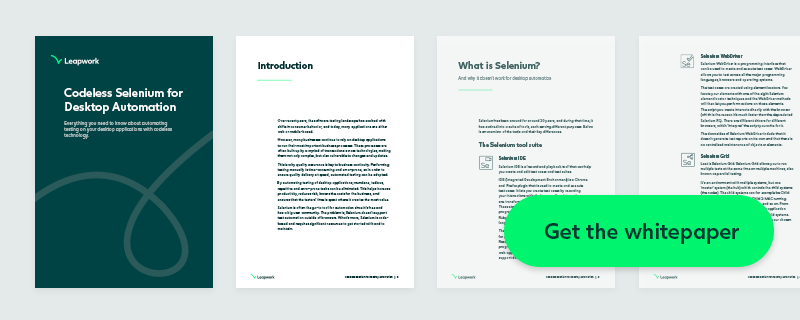Tools for Desktop Automation: What to Look For
As a tester, the first place you start looking for an automation tool is typically among open-sourced options.
Open-sourced automation tools have the benefits of being free and typically also having a large community of fellow testers that can help and provide the documentation they need to get started with test automation.
One popular open-sourced tool is Selenium, which has a huge user community and a diverse testing tool suite. However, Selenium is designed to automate web applications, not desktop applications.
Read more: Can Selenium be used for desktop automation?
Desktop applications differ from web applications in that they are typically installed on a personal computer or workstation, in which case the testing process is simplified somewhat. Web applications, on the other hand, must be tested with multiple browsers and operating systems, and have an unlimited number of simultaneous users. This has implications for the testing approach, as well as the testing tool.
Besides Selenium, there are a series of other open-sourced automation tools, such as Twin, Jau, and White, that allow you to automate desktops, and which are actually designed for it.
However, these tools still have limitations. White, for example, only works for Windows desktop automation. So if you want to automate across operating systems, you’ll have to use multiple tools.
When taking this approach, testers see that, down the road, their testing suites become more and more complex, and therefore require more time for maintenance, taking away time from test design and improvement.
This is why many testers eventually choose to switch to a commercial tool that will allow them to scale and easily maintain their testing efforts.
If you find yourself in this situation and are on the lookout for a new testing tool, there are a number of features that you should look for in the desktop test automation tool.
As a minimum, a desktop test automation tool should have:
- Broad technology support, allowing you to automate any technology and across technologies within a single automation flow
- Accurate and intelligent object recognition, allowing you to easily identify and automate anything in the desktop UI, even when changes occur
- A visual language for setup, rather than code, allowing anyone on your team to work with the tool, regardless of programming capabilities or preferences, and minimizing maintenance burdens
- Video logs for troubleshooting, allowing you to quickly find and fix any issues when they occur.
If your tool encompasses these capabilities, it is possible to do automated end-to-end testing, increasing the speed of testing along with the quality.
For example, within a single flow, you can log in to a web app and place an order, check that the order is placed in your ERP system, verify that the user’s data is updated in your CRM system, validate that payment goes through, and so on.
One tool that makes this possible is Leapwork’s no-code automation platform.
Leapwork has the desktop UI-capabilities you need to build dependable test flows for any desktop application emulating real user interaction with 100% accuracy.
To set up automation flows, all you need to do is click in and between applications (like a user of the desktop application would) to capture the elements needed for your test case.
The codeless desktop automation approach will allow you to:
- Create, run, and troubleshoot automation cases for your core business applications, such as a front-office CRM or a back-office ERP.
- Automate across technologies as Leapwork natively supports all common application platforms: WinForms, WPF, Windows Universal Applications, Win32, Qt, Java, SAP GUI, and many others.
- Automate terminals, legacy systems, and custom-built applications.
- Monitor system health of your business-critical applications or user processes around the clock on both local and remote environments.
- Get immediate alerts when something fails and easily troubleshoot any failed tests with video logs.
Learn more about Leapwork's no-code automation platform in our desktop automation webinar, or download our comprehensive whitepaper on codeless Selenium for desktop automation to uncover what you should look for in a tool for desktop automation.

